 |
BS 1363 classic plugs and sockets |
 |
BS 1363 classic plugs and sockets |
| A few examples of BS 1363 plugs and
sockets made
in the 1950s and '60s are shown below. Their look is classic, but
functionality is identical to modern material.
Sockets have safety shutters and switches. Power pins (L and N) of
plugs made before 1994 are not partially insulated. |
 |
 |
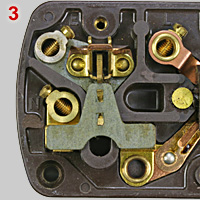 |
 |
 |
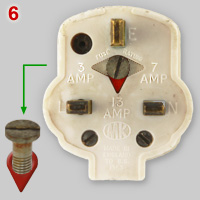 |
 |
| 1, 2 |
Single
BS 1363 surface mount socket, made by MK Electric in the 1950s. The
cast has been made of Bakelite or a comparable phenol or cresol resin.
The model represents one of the most commonly used outlets in the UK
back in the days when one socket per room was seen as quite sufficient.
Image nos. 2-4 shows the inside. {DF} |
| 3, 4 |
Detailed
view of the contact of socket no. 1. Neutral and line contacts
are shielded by a grey plate when the socket is not in use (image no.
3). The earth contact is blocked by a sloped brass bar that is
connected to the shutter plate. When a plug is inserted, the longest
pin - the earth pin* - pushes the bar and shutter plate aside. Then,
the shorter neutral en line pin can be connected to the socket contacts
(image no. 4). * earth pin is not visible because of an image editing trick, otherwise the plug would have obscured the shutter opening mechanism. |
| 5 | Inside
view of a 1960s BS 1363 plug. Wire
colours are indicates as red (Line),
black (Neutral) and green (Earth). In the early 1970s the colour code for flexible (appliance) cords was changed* to: L = brown, N = blue and E = yellow/green. An important reason was avoiding the use of both red and green wires, a serious problem for red-green colourblind people (ca. 6% of men and 0.5% of women). * for fixed wires the use of red, black and green was permitted until 2006. |
| 6 | Late 1950s or early 1960s type of BS 1363 plug equipped with a fuse rate indicator (red arrow). When another type of fuse is installed, the position of the indicator has to be adapted manually. Note the choice between 3A, 7A and 13A plugs These ratings were specified in the original BS 1363:1947 specifications. Nowadays 5A and 13A are the preferred BS 1362 fuse ratings for rewirable plugs. Quite soon after introduction 7A and 10A fuses were deleted from the official list of recommended ratings, but they are still available. Manufacturer: MK Electric. {JM} |
| 7 | 1970s
BS 1363
plug with build-in on/off switch*. This older example also has an
inspection hole in the plug
housing (see inset), a feature to
facilitate verification whether the earth pin is wired.
Modern BS 1363
plugs do not have inspection holes anymore, in contrast to BS 546
plugs. Manufacturer: MK
Electric. {GP} * switched plugs are still available [2015], but sales dropped when switched sockets became the preferred type. |
 |
 |
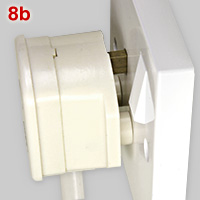 |
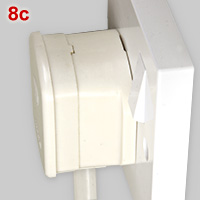 |
 |
 |
 |
| 8 | BS 1363 plug with spring loaded pin
sleeves. The sleeves, which are 7.5 mm long, offer protection against
touching pins under tension; see image nos 8a, 8b and 8c. The inset
shows a sleeve that has been pressed down by a stick. MK Electric started production of plugs with spring loaded sleeves in the 1960s. Pins with integrated insulating sleeves became mandatory in 1994. Since L-red, N-black and E-green (see image no, 5) is not indicated anymore the shown plugs dates back to the 1970s, or later. The plug does not have an earth wire inspection hole (see image no. 7). Sales have always been limited because plugs were considerably more expensive than standard plugs without pin insulation. {GP} A video on Flameport Enterprise Electric Museum shows a disassembled spring loaded plug in detail. |
| 8a,b,c | a: plug has been inserted in BS 1363
socket deep enough to open safety shutters, but line and neutral pins
have not yet touched socket contacts. b: plug position in which connection between pins and socket contacts has just been made. Power pins are fully shielded by sleeves. c: sleeves are pushed in completely, making full contact between pins and socket contacts possible. |
| 9 - 11 | BS
1363 multi-plug with a single BS 1363 outlet (top) and two BS 4573
(shaver plug)
outlets (left and right). The multi-plug is fused as image no.
10 shows. Line pin 'a' is connected to strip 'b' and fuse clip 'c'.
Fuse: 13A BS 1362. Fuse clip 'd' is connected, to strip 'e' to which
the three line outlet contacts are attached. BS 1363 outlet is
protected by a safety shutter (image no. 11). The earth pin of a flex
cord plug pushes shutter aside and makes line and neutral contacts
accessible. Manufacturer: MK Electric. {DH} |
 |
 |
 |
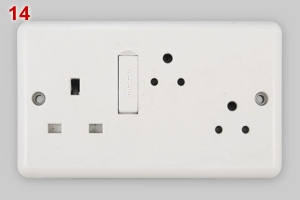 |
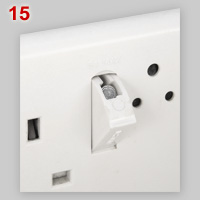 |
|
| 12, 13 | BS
1363
socket with unbreakable and resilient rubber casing. For optimal
protection the casing is a hollow single piece
construction with lid
(image no. 13, right) that gives access to wire connections and fuse.
Manufacturer. William Sanders & Co. in Wednesbury. Dating: 1950s -
60s. The red, black, green wire colour code has been used for flex
cords until the early 1970s. The original 1938 patent application describes the invention for unfused round pin plugs. Patent GB5513166 was granted in 1939. Patent claim that "the plug-top type would not be subject to damage in the event being dropped or crushed" remained valid for BS 1363 plugs. The big S logo stood for Sanders Superior Switchgear (see History of Wednesbury). {IG} |
| 14, 15 |
BS 1363
socket, with two outlets for 2A BS 546 plugs. Because standard BS 546
plugs do not have a fuse, an additional BS
1362 fuse has been added for the two round pin outlets. Image no. 15
shows the fuse compartment in detail. Indicated is a maximum fuse rate
of 5A. This type of socket is no
longer produced. Manufacturer: Midland Electrical Manufacturing (MEM). {GF} |
| |
D i g i t a l M u s e u m o f | |
P l u g s a n d S o c k e t s | |